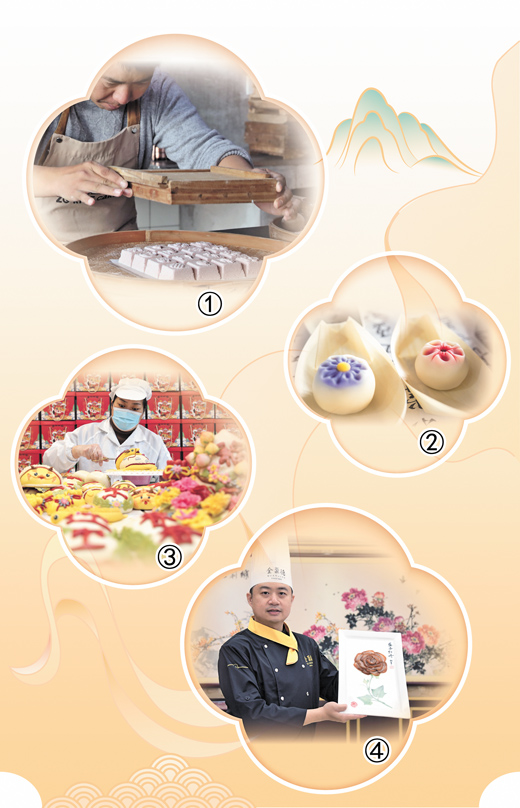




- BRNN
- BRI News
- BRNN News
- Database
Official Documents Polices and Regulations
Inter-government Documents International Cooperation BRI Countries
Business Guide Economic Data BRI Data
Trade
Investment Projects Latest projects
Cases - Content Pool

1. Yang Qinfeng, an inheritor of intangible cultural heritage in Qingpu district, Shanghai, makes Liantang rice cakes. (Xinhua/Liu Ying)
2. Photo shows traditional pastries in Jianyang district, Nanping city, southeast China's Fujian Province. (Photo/Tang Wenjuan)
3. A baker creates colorful steamed buns, an intangible cultural heritage in Huaibei city, east China's Anhui Province. (Photo/Wan Shanchao)
4. Chef Xia Zhipeng presents roast duck slices shaped like a peony at a Quanjude restaurant in Wangfujing, Dongcheng district, Beijing. (Xinhua/Ren Chao)
In 2023, China's catering industry achieved record-breaking revenue of over 5.2 trillion yuan ($722.4 billion). The integration of Guochao, or "China-chic," a popular consumer trend, has infused the industry with fresh momentum, offering consumers novel experiences.
At Gong Yan, a restaurant on Qianmen Street in Beijing, customers are treated to a truly immersive dining experience. Upon entering, guests find themselves served by staff dressed in outfits inspired by ancient dynasties. The restaurant's decor, reminiscent of a grand imperial banquet, enhances the ambiance and charm.
Guochao elements have long influenced the catering industry, with many well-known and time-honored brands incorporating these traditional themes.
The Beijing Hotel recently held a special event in its lobby, showcasing various traditional crafts like sugar figurines, sugar paintings, paper-cutting, and Chinese knots, all representing intangible cultural heritage. The event featured displays, interactive activities, and live demonstrations, allowing guests to experience and appreciate the charm of traditional Chinese culture and its intangible heritage.
"We want to highlight intangible cultural heritage through the popular Guochao trend, which has gained significant popularity among the younger generation," stated a Beijing Hotel executive.
Now, many restaurants are integrating Guochao elements into their dishes.
For example, TIDU, a roast duck brand in Beijing, serves its delectable roast ducks on trays shaped like "Ruyi," a traditional Chinese ornament symbolizing good fortune. The roast duck is prepared in three different dishes, each offering five distinct flavors, according to Xu Changlin, general manager of TIDU.
"The Ministry of Commerce has designated 2024 as a 'year of consumption promotion.' The catering industry should embrace new consumption trends and explore growth opportunities in digital, green, health, and Guochao consumption. By doing so, the industry can become a significant force in driving demand," stated Chen Xinhua, president of the China Hospitality Association.
The rapid growth of livestreaming and cross-border e-commerce has spurred innovation in Chinese pastry products, including flaky pastries, stuffed pastries, and cakes, focusing on the domestic market and catering mainly to younger consumers. The overseas market has also seen significant expansion.
A survey has shown that 58.4 percent of consumers prioritize taste and flavor when making purchases, while over 40 percent consider product quality and price. Additionally, more than 30 percent of consumers take into account popularity and brand recognition.
Chinese pastries, known for their use of medicinal ingredients and emphasis on low sugar and fat content, are gaining popularity. As traditional culture is promoted and time-honored brands expand internationally, there are new opportunities for these pastries to encourage a healthier, more diverse industry.
Data from Tianyancha.com, an online query platform for company information, shows there are currently over 25,000 companies related to Chinese pastries. Industry experts view these pastries as a way to promote Chinese culture. Beyond traditional brick-and-mortar stores, brands are encouraged to expand online sales overseas, expanding their reach through e-commerce platforms, social media, and other avenues.
Currently, young consumers are the primary consumer group for snack products. Among these, Guochao products that highlight individuality and cultural appeal are particularly favored.
In terms of packaging, snacks featuring Guochao elements immediately draw consumer interest. The designs are inspired by traditional Chinese performing arts, such as shadow puppetry and Peking Opera, and cultural elements like ancient artifacts and architecture.

Tel:86-10-65368972, 86-10-65369967